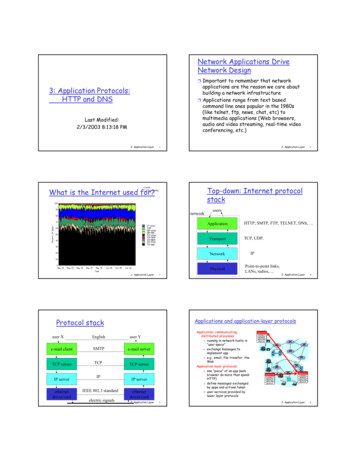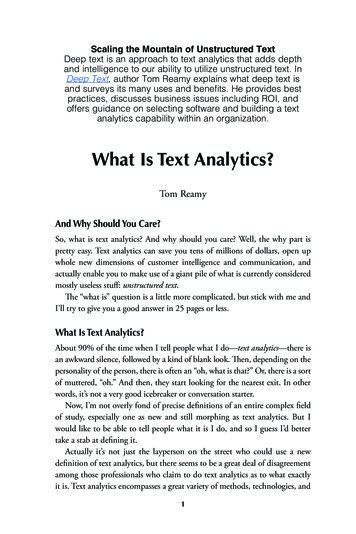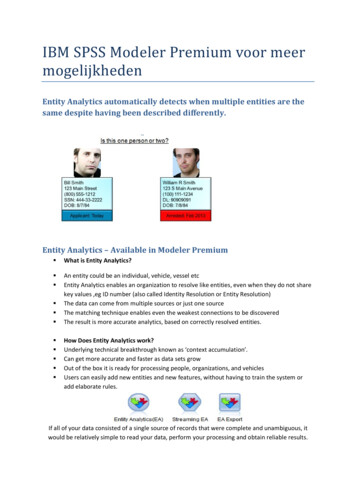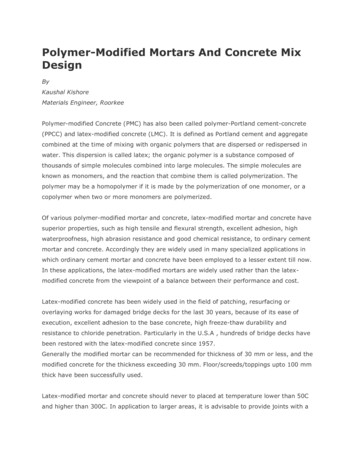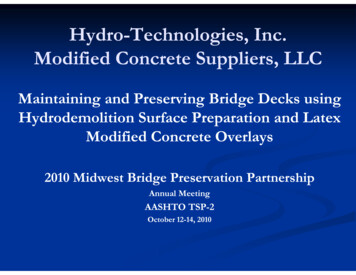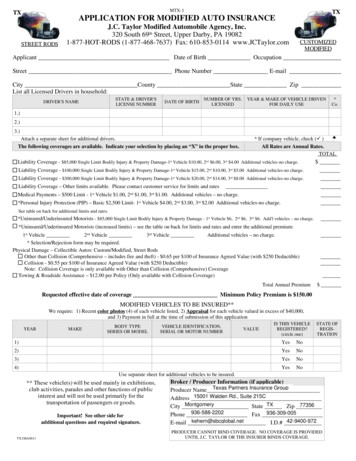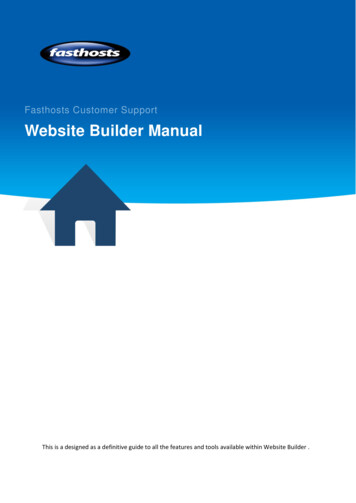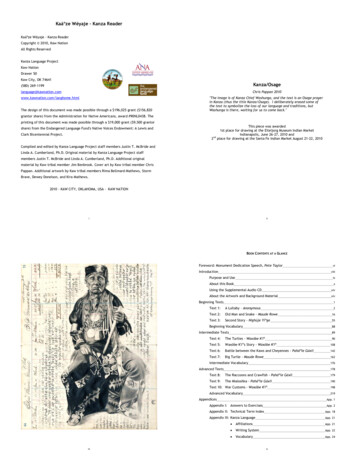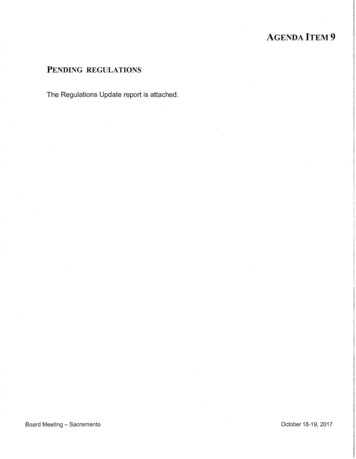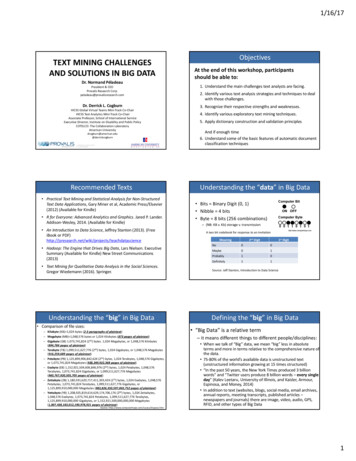
Transcription
SECOND MODIFIED TEXTLegend:UnderlinedIndicates proposed regulatory language.StrikeoutIndicates proposed deletions to the original text.Double UnderlinedIndicates proposed additions to the original text.Italicized Double Underlined Indicates proposed additions to the modified text.Italicized Double StrikeoutIndicates proposed deletions to the modified text.Article 3. Educational ProgramsAdd Section 1109 to Article 3 of Division 11 of Title 16 of the California Code ofRegulations (CCR) to read as follows:§ 1109. Approval of Curriculum Requirements for Radiographic Decision-Makingand Interim Therapeutic Restoration Courses for the Registered DentalHygienist (RDH), Registered Dental Hygienist in Alternative Practice (RDHAP),and Registered Dental Hygienist in Extended Functions (RDHEF).(a) The Dental Hygiene Board of California (Board) shall approve only thoseeducational courses in Radiographic Decision-Making (RDM) and InterimTherapeutic Restorations (ITR) for the Registered Dental Hygienist (RDH),Registered Dental Hygienist in Alternative Practice (RDHAP), and RegisteredDental Hygienist in Extended Functions (RDHEF) pursuant to sections 1910.5,1921, and 1926.05 of the Business and Professions Code that continuouslymeet all course requirements. Continuation of approval will be contingent uponcompliance with these requirements, in addition to the requirements set forth bysections 1104 through 1108 of Article 3 regarding Educational Programs. Eachapproved course shall be subject to Board review at any time for compliancewith curriculum requirements. Course providers shall be responsible fornotifying the Board in writing of any changes to the course content, physicalfacilities, and faculty within ten (10) days of such changes.(b) Approval of RDM or ITR Educational Courses for the Student Enrolled in aDental Hygiene Educational Program (DHEP). To be approved, an educationalprogram shall comply with the following requirements:Dental Hygiene16 CCR 1109Modified TextCourses in RDM and ITRPage 1 of 117/22/21
(1) DHEP RDM Course Requirements.(A) A California DHEP shall submit to the Board an “Application for Approvalof a Course for Radiographic Decision-Making in a Dental HygieneEducational Program” DHBC RDM-01 (New 01/1907/21), herebyincorporated by reference;(B) Submit a 300 application fee to the Board; and(C) The course shall be sufficient in length for the students to developcompetency in making decisions regarding which radiographs to exposeto facilitate diagnosis and treatment planning by a dentist but shall be, at aminimum, four (4) hours in length and include didactic, laboratory, andsimulated clinical experiences.(D) New or already approved DHEPs seeking to incorporate or offer a standalone permit course in RDM shall submit to the Board an “Application forApproval of a Course for Radiographic Decision-Making in a DentalHygiene Educational Program,” DHBC RDM-01 (New 01/1907/21) and a 300 application fee prior to instruction.(2) DHEP ITR Course Requirements.(A) A California DHEP shall submit to the Board an “Application for Approvalof a Course for Interim Therapeutic Restorations in a Dental HygieneEducational Program” DHBC ITR-03 (New 01/1907/21), herebyincorporated by reference; and(B) Submit a 300 application fee to the Board; and(C) The course shall be sufficient in length for the students to developcompetency in placement of protective restorations but shall be, at aminimum, sixteen (16) hours in length, including four (4) hours of didactictraining, four (4) hours of laboratory training, and eight (8) hours of clinicaltraining.(D) New or already approved DHEPs seeking to incorporate or offer a standalone permit course in ITR shall submit to the Board an “Application forApproval of a Course for Interim Therapeutic Restorations in a DentalHygiene Educational Program,” DHBC ITR-03 (New 01/1907/21) and a 300 application fee prior to instruction.(3) In addition to the instructional components described in this subdivision, anRDM or ITR DHEP educational course shall be established at thepostsecondary educational level.Dental Hygiene16 CCR 1109Modified TextCourses in RDM and ITRPage 2 of 117/22/21
(c) Approval of RDM or ITR Continuing Educational (CE) Courses for the RDH,RDHAP, and RDHEF. All courses must be approved by the Board beforeoffered by the provider. To be approved, an educational program shall complywith the following requirements:(1) RDM CE Course Requirements.(A) An applicant course provider shall submit to the Board an “Application forApproval of a Continuing Educational Course in Radiographic DecisionMaking for the RDH, RDHAP, and RDHEF” DHBC RDM-02 (New01/1907/21), hereby incorporated by reference; and(B) Submit a 300 application fee to the Board; and(C) The course shall be sufficient in length for the participants to developcompetency in making decisions regarding which radiographs to exposeto facilitate diagnosis and treatment planning by a dentist but shall be, at aminimum, four (4) hours in length and include didactic, laboratory, andsimulated clinical experiences.(2) ITR CE Course Requirements.(A) An applicant course provider shall submit to the Board an “Application forApproval of a Continuing Educational Course in Placement of InterimTherapeutic Restorations for the RDH, RDHAP, and RDHEF” DHBC ITR04 (New 01/1907/21), hereby incorporated by reference; and(B) Submit a 300 application fee to the Board; and(C) The course shall be sufficient in length for the participants to developcompetency in placement of protective restorations but shall be, at aminimum, sixteen (16) hours in length, including four (4) hours of didactictraining, four (4) hours of laboratory training, and eight (8) hours of clinicaltraining.(3) In addition to the instructional components described in subdivisions (c)(1)and (c)(2), a program or course shall be established at a post-graduateeducational level.(d) Requirements for Approval of DHEP and CE RDM and ITR Courses.(1) Administration.To be approved, each course shall provide the resources necessaryincluding, but not limited to, equipment and facilities, to satisfy the educationalDental Hygiene16 CCR 1109Modified TextCourses in RDM and ITRPage 3 of 117/22/21
requirements as specified in this section. Course providers shall beresponsible for informing the Board of any changes in writing to the coursecontent, physical facilities, and faculty within ten (10) days of such changes.(2) Admission.(A) To be eligible for admission to an RDM or ITR Course for the Student in aDHEP, students shall:(i) Be a student in good standing in a DHEP; and(ii) Possess current certification in Basic Life Support (BLS) andCardiopulmonary Resuscitation (CPR) from the American HeartAssociation (AHA) or the American Red Cross (ARC), or aprovider approved by the American Dental Association'sContinuing Education Recognition Program (CERP) or theAcademy of General Dentistry's Program Approval forContinuing Education (PACE).(B) To be eligible for admission to a CE Course in RDM or ITR for the RDH,RDHAP, and RDHEF, participants shall:(i) Possess a valid, active license as an RDH, RDHAP, or RDHEFissued by the Board, and(ii) Possess current certification in Basic Life Support (BLS) andCardiopulmonary Resuscitation (CPR) from the American HeartAssociation (AHA) or the American Red Cross (ARC), or a providerapproved by the American Dental Association's ContinuingEducation Recognition Program (CERP) or the Academy ofGeneral Dentistry's Program Approval for Continuing Education(PACE).(3) Faculty.Didactic, laboratory, preclinical, and clinical faculty, including the program orcourse director and supervising dentist(s) shall:(A) Possess a valid, active California RDH, RDHAP, RDHEF license, orDoctor of Dental Surgery (DDS) license, or Doctor of Dental Medicine(DMD) license with no disciplinary actions in any jurisdiction to practicedental hygiene or dentistry;(B) Possess current certification in Basic Life Support (BLS) andCardiopulmonary Resuscitation (CPR) from the American HeartAssociation (AHA) or American Red Cross (ARC), or a provider approvedDental Hygiene16 CCR 1109Modified TextCourses in RDM and ITRPage 4 of 117/22/21
by the American Dental Association's Continuing Education RecognitionProgram (CERP) or the Academy of General Dentistry's ProgramApproval for Continuing Education (PACE);(C) RDH, RDHAP, and RDHEF faculty shall possess current licensure in RDMand ITR placement; and(D) Be calibrated in instruction and grading of RDM and ITR as provided in 16CCR section 1105.1(c)(2).(4) Facilities and Equipment.(A) RDM and ITR Courses for the Student in a DHEP.Didactic instruction may take place in an in-person or an onlineenvironment. Each course shall have access to adequate equipment andfacilities for lectures and testing.Laboratory and clinical instruction shall be held at a physical facility.Physical facilities and equipment shall be maintained and replaced in amanner designed to provide students with a course that will meet theeducational objectives set forth in this section. A physical facility shallhave all the following:(i)A patient clinic area, laboratory, and a radiology area;(ii)Access to equipment necessary to develop dental hygiene skills inRDM and ITR duties; and(iii)Infection control equipment shall be provided as described in 16CCR section 1005.(B) RDM CE Courses for the RDH, RDHAP, and RDHEF.Didactic instruction may take place in an in-person or an onlineenvironment. Each course shall have access to adequate equipment andfacilities for lectures and testing and shall be maintained and replaced in amanner designed to provide participants with a course that will meet theeducational objectives set forth in this section.(C) ITR CE Courses for the RDH, RDHAP, and RDHEF.Didactic instruction may take place in an in-person or an onlineenvironment. Each course shall have access to adequate equipment andfacilities for lectures and testing.Laboratory and clinical instruction shall be held at a physical facility.Physical facilities and equipment shall be maintained and replaced in aDental Hygiene16 CCR 1109Modified TextCourses in RDM and ITRPage 5 of 117/22/21
manner designed to provide participants with a course designed to meetthe educational objectives set forth in this section. A physical facility shallhave all the following:(i)A patient clinic area, laboratory, and a radiology area;(ii)Access to equipment necessary to develop dental hygiene skills inITR duties; and(iii)Infection control equipment shall be provided as described in 16CCR section 1005.(5) Health and Safety.DHEP and CE course providers shall comply with all local, state, and federalhealth and safety laws and regulations.(A) All students or participants shall have access to the course'shazardous waste management plan for the disposal of needles,cartridges, medical waste, and storage of oxygen and nitrous oxide tanks.(B) All students or participants shall have access to the course's clinic andradiation hazardous communication plan.(C) All students or participants shall receive a copy of the course'sbloodborne and infectious diseases exposure control plan, which shallinclude emergency needlestick information.(D) Faculty shall review with each student or participant all requirementspursuant to this section.(6) Curriculum and Learning Resources.(A) RDM didactic instruction shall include:(i) Caries Management by Risk Assessment (CAMBRA) concept;(ii) Guidelines for RDM to include, but not limited to, the followingconcepts of:(a) The American Dental Association's Dental RadiographicExaminations: Recommendations for Patient Selection andLimiting Radiation Guidelines on the Selection of Patients forDental Radiographic Examinations and(b) The American Academy of Pediatric Dentistry’sGuidelines on Prescribing Dental Radiographs.Dental Hygiene16 CCR 1109Modified TextCourses in RDM and ITRPage 6 of 117/22/21
(iii) The guidelines developed by Pacific Center for Special Care atthe University of the Pacific Arthur A. Dugoni School of Dentistry(Pacific) for use in training for Health Workforce Pilot Project(HWPP) #172 including:(a) Instruction on specific decision-making guidelinesthat incorporate information about the patient's health,radiographic history, time span since previousradiographs were taken, and availability of previousradiographs; and(b) Instruction pertaining to the general condition of themouth including extent of dental restorations present, visiblesigns of abnormalities, including broken teeth, dark stainwithin the tooth, and visible holes in teeth.(B) RDM laboratory instruction shall include a review of clinical caseswith instructor-led discussion about radiographic decision-making inclinical situations.(C) RDM simulated-clinical instruction shall include case-basedexamination with various clinical situations where trainees make decisionsabout which radiographs to expose and demonstrate competency tofaculty based on these case studies.(D) Didactic, laboratory, and clinical instruction in ITR placement shallinclude:(i) Review of pulpal anatomy.(ii) Theory of adhesive restorative materials used in the placementof adhesive protective restorations including mechanisms ofbonding to tooth structure, handling characteristics of the materials,preparation of the tooth prior to material placement, and placementtechniques.(iii) Criteria used in clinical dentistry pertaining to the use andplacement of adhesive protective restorations; Criteria which shallinclude, but not limited to:(a) Patient factors:(1) According to the American Society ofAnesthesiologists Physical Status Classification, thepatient is Class III or less;Dental Hygiene16 CCR 1109Modified TextCourses in RDM and ITRPage 7 of 117/22/21
(2) The patient is cooperative enough to have theinterim restoration placed without the need for specialprotocols, including sedation or physical support;(3) The patient, or responsible party, has providedconsent for the ITR procedure; and(4) The patient reports that the tooth is asymptomatic,or if there is mild sensitivity which stops within a fewseconds of the removal of the offending stimulus.(b) Tooth Factors:(1) The lesion is accessible without the need forcreating access using a dental handpiece;(2) The margins of the lesion are accessible so thatclean, non-involved margins can be obtained aroundthe entire periphery of the lesion with the use of handinstrumentation;(3) The depth of the lesion is more than twomillimeters from the pulp on radiographic examinationor is judged by the DDS or DMD to be a shallowlesion such that the treatment does not endanger thepulp or require the use of local anesthetic; and(4) The tooth is restorable and does not have othersignificant pathology.(iv) Theory of protocols to deal with adverse outcomes used in theplacement of adhesive protective restorations includingmechanisms of bonding to tooth structure, handling characteristicsof the materials, preparation of the tooth prior to materialplacement, and placement techniques;(v) Criteria for evaluating successful completion of adhesiveprotective restorations including, but not limited to, restorativematerial not in hyper occlusion, no marginal voids, and minimalexcess material;(vi) Protocols for adverse outcomes after ITR placement including,but not limited to; exposed pulp, tooth fracture, gingival tissueinjury, high occlusion, open margins, tooth sensitivity, roughsurface, complications, or unsuccessful completion of adhesiveprotective restorations including situations requiring immediatereferral to a dentist; andDental Hygiene16 CCR 1109Modified TextCourses in RDM and ITRPage 8 of 117/22/21
(vii) Protocols for follow-up of adhesive protective restorations,including, but not limited to, at least two (2) follow-up examinationsof the ITR within a twelve (12) month period.(E) Laboratory instruction in ITR placement shall include placement ofadhesive protective restorations where students and participantsdemonstrate competency in this technique on typodont teeth.(F) Clinical instruction in ITR shall include experiences where studentsand participants demonstrate placement of ITRs under directsupervision of faculty.(EG) Minimum ITR Requirements.(i) Laboratory instruction shall include placement of ten (10)adhesive protective restorations where students or participantsdemonstrate competency in this technique on typodont teeth.(ii) Clinical instruction shall include experiences where students orparticipants demonstrate, at a minimum, the placement of five (5)adhesive therapeutic restorations that shall be evaluated by theprogram faculty to criteria-referenced standards.(FH) Curriculum shall require adherence to infection control standards asprovided in 16 CCR section 1005.(GI) Curriculum shall prepare the student or participant to assess, plan,implement and evaluate procedures as provided in subdivision (c)(6) ofthis section to perform with competence and judgment.(HJ) Students or participants shall be provided a course syllabus thatcontains:(i) Course learning outcomes;(ii) Titles of references used for course materials;(iii) Content objectives; and(iv) Grading criteria which includes competency evaluations andlaboratory, preclinical, and clinical rubrics to include problemsolving and critical thinking skills that reflect course learningoutcomes.(IK) Successful completion shall require students or participants toachieve competency at a minimum of 75% in each of the competencies.Dental Hygiene16 CCR 1109Modified TextCourses in RDM and ITRPage 9 of 117/22/21
(7) Recordkeeping.DHEP and CE course providers shall possess and maintain the following for aperiod of not less than five (5) years:(A) Individual student or participant records, including those necessary toestablish satisfactory completion of the course;(B) Copies of lab and clinical competency documents;(C) Copies of faculty calibration plans, faculty credentials, licenses, andcertifications including documented background in educationalmethodology within the previous two years;(D) Copies of student or participant course evaluations and a summationthereof; and(E) Copies of curriculum, including course syllabi, exams, sample testquestions and clinic rubrics.(e) Satisfactory completion of courses in RDM and ITR placement shall be determinedusing criteria-referenced completion standards, where the instructor determines whenthe student or participant has achieved RDM and ITR placement competency based onthese standards, including the duration of time needed to achieve competency. Anystudent or participant who does not achieve competency in these duties in the specifiedperiod of instruction may receive additional education and evaluation, or, in thejudgment of the faculty, may be discontinued from the RDM or ITR courses.(f) Certificates of Completion. Pursuant to the regulatory requirements set forth by 16CCR section 1016, subdivision (h)(1), only after a student or participant hassuccessfully completed the requirements of a course in RDM, ITR, or RDM and ITR,may a DHEP or course provider provide the student or participant with an original“Certification of Completion of a Course in Interim Therapeutic Restoration for the RDH,RDHAP, and RDHEF”, “Certification of Completion of a Course in RadiographicDecision-Making for the RDH, RDHAP, and RDHEF”, or “Certification of Completion ofa Course in Radiographic Decision-Making and Interim Therapeutic Restorations for theRDH, RDHAP, and RDHEF”, as applicable.(g) Appeals.(1) The Board may deny or withdraw its approval of a course for noncompliancewith this section. If the Board denies or withdraws approval of a course, thereasons for withdrawal or denial will be provided in writing within sixty (60)business days.Dental Hygiene16 CCR 1109Modified TextCourses in RDM and ITRPage 10 of 117/22/21
(2) Any course provider or applicant whose approval is denied or withdrawn shallbe granted an informal conference before the Executive Officer or his or herdesignee prior to the effective date of such action. The applicant or courseprovider shall be given at least ninety (90) business days' notice of the time andplace of such informal conference and the specific grounds for the proposedaction.(3) The applicant or course provider may contest the denial or withdrawal ofapproval by either:(A) Appearing at the informal conference. The Executive Officer shallnotify the course provider of the final decision of the Executive Officerwithin thirty (30) business days of the informal conference. Based on theoutcome of the informal conference, the course provider may then requesta hearing to contest the Executive Officer's final decision. A courseprovider shall request a hearing by written notice to the Board within thirty(30) business days of the postmark date of the letter of the ExecutiveOfficer's final decision after informal conference. Hearings shall be heldpursuant to the provisions of Chapter 5 (commencing with Section 11500)of Part 1 of Division 3 of Title 2 of the Government Code; or(B) Notifying the Board in writing the course provider's election to foregothe informal conference and to proceed with a hearing pursuant to theprovisions of Chapter 5 (commencing with Section 11500) of Part 1 ofDivision 3 of Title 2 of the Government Code. Such notification shall bemade to the Board before the date of the informal conference.NOTE: Authority cited: Sections 1905, 1906, and 1910.5, Business and ProfessionsCode. Reference: Section 1910.5, Business and Professions Code.Dental Hygiene16 CCR 1109Modified TextCourses in RDM and ITRPage 11 of 117/22/21
Educational Programs Add Section 1109 to Article 3 of Division 11 of Title 16 of the California Code of Regulations (CCR) to read as follows: § 1109. Approval of Curriculum Requirements for Radiographic Decision-Making . (RDHEF) pursuant to sections 1910.5, 1921, and 1926.05 of the Business and Professions Code that continuously
